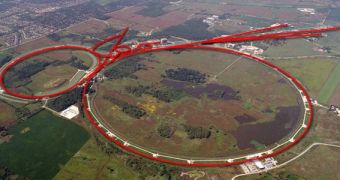In a new series of physics experiments set-up in particle accelerators, researchers were able to account for why we, and indeed the Universe, exists. As any physics expert will tell, we theoretically shouldn't be here. Neither should galaxies, stars, black holes, cosmic gas, and everything in between. Since matter and antimatter were produced in equal amounts during the Big Bang, at the beginning of the Universe, it stands to reason that they should have annihilated each other. Obviously, this did not happen, Space reports.
Experts have been scratching their heads over this issue ever since it was first pointed out, but now scientists at the US Department of Energy's (DOE) Fermi National Accelerator Laboratory (Fermilab) believe they may have found an explanation. They argue that, while it's true matter and antimatter generally tend to interact with each other violently, and then destroy each other completely, there are instances in which regular matter emerges victorious from this battle. However, the group points out the fact that the amount of matter which endures the “struggle” is not a significant one.
Their test results have revealed that only about 1 percent of the initial amount of matter placed in the equation endures, whereas all of the antimatter is annihilated. The new knowledge may finally help scientists explain how everything we know came into being after the Big Bang. This was an event about 13.7 billion years ago, which saw the creation of equal amounts of matter and antimatter from a singularity. According to theory, everything should have stopped there, but matter somehow prevailed, and generated billions upon billions of galaxies, stars and other celestial objects.
The Fermilab researchers say that their newest results go way beyond the matter-antimatter symmetry violation proposed by the Standard Model. The amount of leeway this theory gave to surviving matter was not enough to account for why so much matter exists in the Universe, accompanied by so little of its “arch-nemesis.” Eight years-worth of data was analyzed for the new study, which was unveiled on Tuesday. The information was gathered by the renowned Tevatron particle accelerator at Fermilab, and they dealt with the differences that occurred between pairs of muons and antimuons resulted from B mesons decay.
“Many of us felt goose bumps when we saw the result. We knew we were seeing something beyond what we have seen before and beyond what current theories can explain,” explains University of Manchester particle physicist Stefan Soldner-Rembold. A paper describing the full results has been submitted for publication to the highly-regarded international journal Physical Review D.

 14 DAY TRIAL //
14 DAY TRIAL //